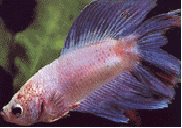As you already know, male bettas originally had short fins. In the wild, all bettas still do. Long fins was a mutation from the original form and (surprisingly) is dominant. Selective breeding has created many different shapes of tails, and I know some breeders who are focusing all their efforts in obtaining specific tail shapes. As years go by, the standards of what is a desirable tail shape have changed, and continue changing. The "droopy" veil tails have been replaced by the more showy fan tails, then Delta tails and now many breeders are working hard at creating the perfect halfmoon tail (see below). Here are a few pictures to illustrate these otherwise abstract shape names:
|
|
Initially , ALL bettas had short tails.
The small fins of this fully grown wild male betta may not be showy but
think about it, would you rather be beautiful, or be alive? In the wild
bettas need to be fast to escape predators and the long fins would be
nothing but trouble. Kind of like going to a war zone in a wedding dress!!
These short finned bettas look like our female bettas, which as you know,
don't grow long fins. Perhaps in the future this also, may
change. |
|
|
A mutation caused short finned bettas to
have longer fins. And the veil tail was created. Veil tails hang down when
the betta is not flaring, and are not much to look at even when bettas
flare. The tail is larger at the base, but almost immediately narrows
down. It is asymmetrical, meaning that if you divide the tail horizontally
(see red line) you would end up with 2 non identical parts. All pet
store bettas are veil tail, and veil tai is no longer a desirable tail
shape. It is my understanding that veil tails are not even allowed to
compete on the show circuit anymore. Hence, breeding pet store bettas is a
huge waste of your time because you will never get quality
finnage. |
|
combtail |
Comb tail is not a tail shape per say but
it does affect the way finnage looks so I wanted to cover it here.
Combtail is a genetic trait that extends the ray beyond the fin edge,
hence making the edge of the fins look like a comb.. It can be observed in
any betta tail shape. I personally really love the combtail trait and if
it were up to me all my bettas would have it ;). Left, a black melano
with combtail from my Midnight Express
line. |
|
fantail |
A fan tail, or round tail, looks like a fan with rounded edges. It is much wider at the ends than it is at the base, resulting in a tail that spreads out open beautifully. If you divide the tail horizontally with an imaginary line, you will have 2 symmetrical parts. Again, there is roundness of the edges (unlike the delta tail which has sharp edges). The tail angle may be wider or narrower, depending on the quality of the line. Left, a young lavender/red male from my Flame strain. |
|
delta tail |
Delta tail was the first step before
achieving halfmoons (see below). Delta is like a fan tail with crisp,
sharp angles at the tail edges. The sharper, the better. Delta tail are
also symetrical, and the angle may vary, but of course the wider the
angle, the better. If the angle is wide, say above 130°, then we have what
we call a "super delta tail". And if the angle reaches a perfect 180° (or
more) then we have a halfmoon! Left "Blue Moon" originally bred by Bonnie
Mckinley and with which I started my Blue Moon line. |
|
halfmoon |
Halfmoon, oh Halfmoon, where are you? That
is the lamentation of many breeders who are currently working hard at
producing more halfmoon tails. It is elusive because it seems to pop up in
spawns, and then forever disappear. You can have 2 perfect halfmoons,
breed them together and not get a single halfmoon fry in the spawn :(.
Usually one gets a few (half dozen maybe) in each spawn. So they are rare
and therefore, way costly. It is a most gorgeous looking tail which, when
flared, looks like a half circle, hence the name "halfmoon". Sometimes, as
the photo to the left illustrate, a betta may have even slightly more than
a 180° angle! This royal blue betta was born in my fishroom in 1998.
In short it is fins galore. Now you understand why everybody is bragging
about having halfmoon bettas? But beware!! Most "Halfmoon" bettas are
nothing but over glorified Delta tails wanna-be halfmoons and do not
have a real 180° angle.. Meaning most breeders who claim to have halfmoons
really don't. They just have nice looking delta tails and that's that. I
actually rarely get halfmoons in my lines because halfmoons are mostly
predominant in the real basic common betta colors such as blue, red and
pastels. A few drawbacks of halfmoons are: their cost ($100 to $250 for a
nice male), a bad tendency to blow their tail (the tail tears), an
inability to flare due to too much finnage weight and a nack for not
wanting to spawn (because halfmoon lines are heavily inbred). For all
above reasons, halfmoons have not been on my top priority list, as much as
creating new colors and variations have. Still, I always enjoy it when one
pops up in my spawns and most of my strains carry the gene. |
|
double tail |
Another cool gene all my strains carry is
the double tail gene, my all time favorite. A Double Tail betta (dt) has
two tail lobes instead of one. It also has twice (sometimes more) as many
rays in the dorsal fin (top fin) as a regular Single Tail (ST) betta,
resulting in a dorsal fin that is twice (or more) larger than a ST betta.
Yes, you get twice as much for the price of one! hehehehe. The ideal
Double Tail betta is one with two large even lobes (such as the yellow
betta to the left, born in my fishroom and with which I started my
Gorgeous Yellow line). Notice how even both lobes are, and how the entire
finnage looks like a perfect circle. This is an outstanding Double
Tail. DT is recessive, but ST bettas that carry the DT gene have
better finnage and larger dorsals then bettas who don't carry DT. Pretty
much all my ST bettas carry the DT gene. (indicated by the symbol: ST/dt). |
|
|
I have never seen this mutation other than in this picture. This betta was bred by Mr. Tanaka, a Japanese breeder. Although the lobes seem to be split I wonder whether we are not actually looking at a regular DT betta with clear spots on his marbled fins, which is quite common in marbles. Note: the top lobe is considerably smaller than the lower lobe, which is a fault. |
|
lyre tail |
This is a lyre tail betta and is also one
of Mr. Tanaka's bettas. Mr Tanaka had, by the way, some
amazing bettas!! This to the left is a blue cambodian. I have actually
never seen a tail like this one in real life but it seemed worthy of being
displayed on this page! Whether it would breed true (and therefore could
be propagated) is another issue
altogether. |
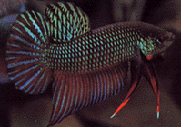
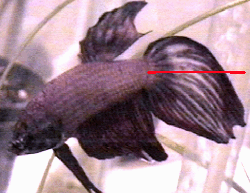
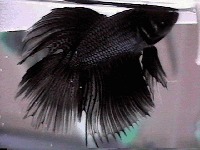
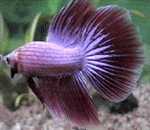
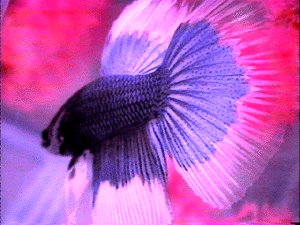
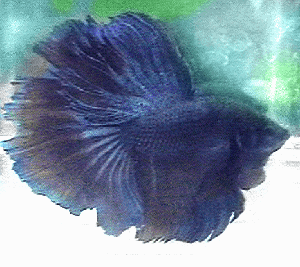
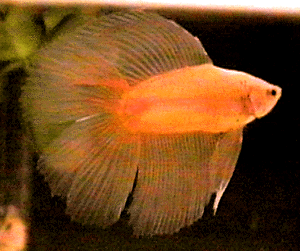
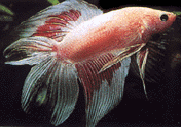 double
split tail
double
split tail